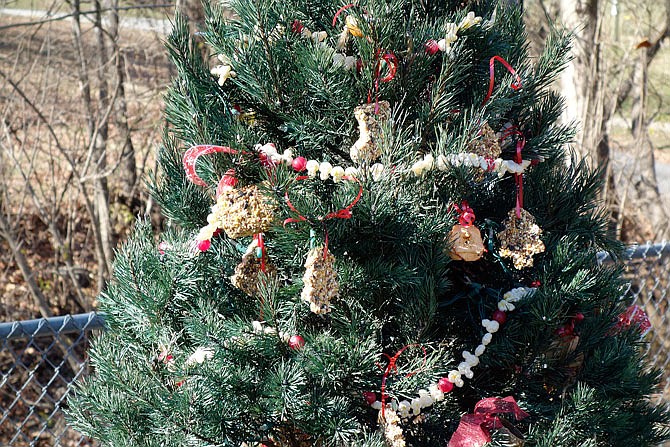Although winter in Missouri is warming up, birds sometimes appreciate a helping hand when it comes to getting enough to eat.
That's why Twillman Feed Service's tree at the Fulton Field of Joy is decorated with handmade bird-seed ornaments.
"When we agreed to do a tree for the feed store, we thought it should be feed related," Lori Twillman said.
She got together with her daughter and grandchildren and created "ornaments" out of toilet paper rolls, peanut butter and of course, birdseed.
"It was a collaborative effort," she said.
Both of the company's feed stores, one in Calwood and another in Mexico, carry some bird feeding goods.
"We have wild bird seed mix, suet, Nyger (thistle) and sunflower seeds," Twillman said. "Sunflower seeds are really popular with our customers."
According to Missouri Department of Conservation officials, some birds (like chickadees and tufted titmice) are finicky diners, while mourning doves and white-throated sparrows will eat just about any seed variety.
The best seeds for attracting birds are black, oil-type sunflower seeds and white millet, which can be purchased separately and blended by hand.
"Sunflower or wild bird seeds, or a mix, are our most-popular," said Andy Chitwood, a department specialist at Westlake Ace hardware in Fulton. "I know that because we get it in by the pallet every week or every other week."
Bird feeding stations can be simple to place, either on the ground, as a feeder on a post or hanging on a tree. A wooden platform on a post can be made in minutes, while other birders prefer fancier structures with roofs and three walls to keep rain off.
If you have a lot of squirrels in the neighborhood, you may want to consider placing feeders well off the ground. Birds Forever suggests putting 10 feet of air around your bird feeder, or trying a squirrel baffle or a specialty feeder. Chitwood said the store has a spring-loaded feeder that is difficult for squirrels to climb.
The type of bird you want to attract may not like your dining arrangements. MDC officials said many songbirds prefer eating directly off the ground, while cardinals and blue jays are more flexible and like platform feeders, too. Goldfinch and chickadees also will visit small feeders affixed to a window via a suction cup.
Some birds such as Baltimore orioles and hummingbirds won't come no matter what feeding method you have - because they have migrated out of the area for the winter. They can be enjoyed, however, every summer.
People can also attract birds by planting the right native trees and shrubs, and flowers in the summer. Holly, hawthorn and persimmon are favorites of cedar waxwings, who arrive in large flocks and stay as long as food lasts.
Remember, when temperatures drop below freezing birds still need to drink water. The Carolina wren and the bluebird, Missouri's state bird, can be enticed to feeding stations during the winter if water is available. You may also furnish them with grit, such as coarse sand or ground shells, to help them digest seeds.
According to Bird Watchers Digest, a list of popular winter bird feed contains:
Black-oil sunflower seed (striped-sunflower seeds are OK, too); peanuts (de-shelled, dry-roasted and unsalted), suet (fat: an excellent source of energy); good quality mixed seeds (minus the filler); Nyjer/thistle seed; safflower seeds; cracked corn, which might also attract turkeys, deer, squirrels and more; mealworms; and fruit such as citrus, apple and banana slices, grapes and even melon rinds. People also can make their own treats, as simple as smearing peanut butter on a tree trunk, or melting suet and pouring into ice cube trays to harden into individual snacks. Just add raisins, peanut bits, fruit or other delicacies.

